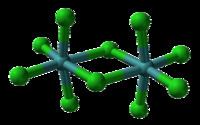Molar mass 273.21 g/mol Melting point 194 °C Density 2.93 g/cm³ | Formula Cl10Mo2 Boiling point 268 °C | |
 | ||
Related molybdenum chlorides Appearance dark-green solid; hygroscopic; paramagnetic | ||
Molybdenum(V) chloride is the inorganic compound with the formula [MoCl5]2. This dark volatile solid is used in research to prepare other molybdenum compounds. it is moisture-sensitive and soluble in chlorinated solvents. Usually called molybdenum pentachloride, it is in fact a dimer with the formula Mo2Cl10.
Contents
Structure
Each molybdenum has local octahedral symmetry and two chlorides bridge between the molybdenum centers. A similar structure is also found for the pentachlorides of W, Nb and Ta. In the gas phase and partly in solution, the dimers partially dissociates to give a monomeric pentahalide. The monomer is paramagnetic, with one unpaired electron per Mo center, reflecting the fact that the formal oxidation state is +5, leaving one valence electron on the metal center.
Preparation and properties
MoCl5 is prepared by chlorination of Mo metal but also chlorination of MoO3. The unstable hexachloride MoCl6 is not produced in this way.
MoCl5 is a strong oxidant. It is reduced by MeCN to afford an orange complex, MoCl4(MeCN)2, which in turn reacts with THF to give MoCl4(THF)2, a precursor to other molybdenum-containing complexes. MoCl5 is reduced by HBr to form MoBr4. The bromination reaction is conducted in ethylbromide at −50 °C, forming MoBr5 as an intermediate. Upon warming to 20 °C, Br2 is produced and the formal oxidation state of molybdenum changes from +5 to +4. The net transformation is shown in the equation:
2 MoCl5 + 10 HBr → 2 MoBr4 + 10 HCl + Br2MoBr4 reacts with THF to give the Mo(III) species mer-MoBr3(THF)3.
MoCl5 is a good Lewis acid toward non-oxidizable ligands. It forms an adduct with chloride to form [MoCl6]−. In organic synthesis, the compound finds occasional use in chlorinations, deoxygenation, and oxidative coupling reactions.
Safety considerations
MoCl5 is an aggressive oxidant and readily hydrolyzes to release HCl.
